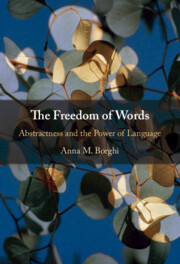Book contents
- The Freedom of Words
- The Freedom of Words
- Copyright page
- Dedication
- Contents
- Figures
- Acknowledgments
- Introduction
- Part I Language and Its Power
- Part II Abstractness and Language
- Chapter 5 Different Varieties of Abstract Concepts
- Chapter 6 Abstractness and Language as a Physical Tool
- Chapter 7 Abstractness and Language as an Inner Tool
- Chapter 8 Abstractness and Language as a Social Tool
- Chapter 9 Conclusion
- Index
- References
Chapter 6 - Abstractness and Language as a Physical Tool
from Part II - Abstractness and Language
Published online by Cambridge University Press: 20 July 2023
- The Freedom of Words
- The Freedom of Words
- Copyright page
- Dedication
- Contents
- Figures
- Acknowledgments
- Introduction
- Part I Language and Its Power
- Part II Abstractness and Language
- Chapter 5 Different Varieties of Abstract Concepts
- Chapter 6 Abstractness and Language as a Physical Tool
- Chapter 7 Abstractness and Language as an Inner Tool
- Chapter 8 Abstractness and Language as a Social Tool
- Chapter 9 Conclusion
- Index
- References
Summary
Chapter 6 illustrates why abstract concepts can be physical tools that modify our perception and interaction with the environment. It focuses on the relationship between abstract concepts and perception, both of the external world and the body. In section 6.1, I describe studies showing the importance of interoception, the ability to detect inner bodily signals for abstract concepts, particularly emotional ones, and contend that they might enhance this capability. The second section illustrates research showing how abstract concepts rely on sensorimotor experience through a metaphorical mapping mechanism. Although metaphorical mapping is powerful, other mechanisms beyond it, and primarily linguistic and social experience, might contribute to explaining abstractness. Finally, I describe how languages and cultures differently influence abstract concepts. A variety of examples, spanning from the concrete concept of container to the abstract concept of time, suggest that abstract concepts are more flexible and variable across languages than concrete concepts.
Keywords
- Type
- Chapter
- Information
- The Freedom of WordsAbstractness and the Power of Language, pp. 182 - 208Publisher: Cambridge University PressPrint publication year: 2023



